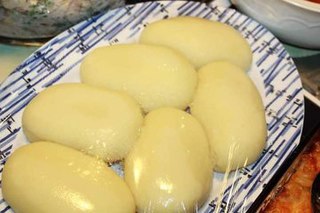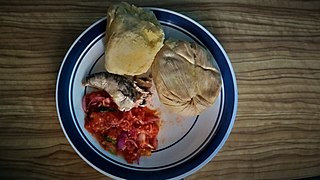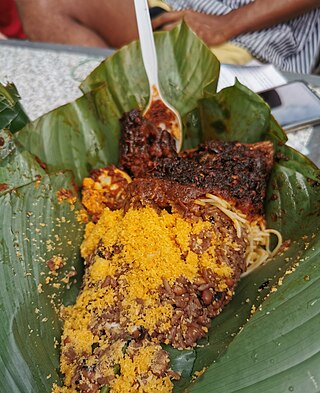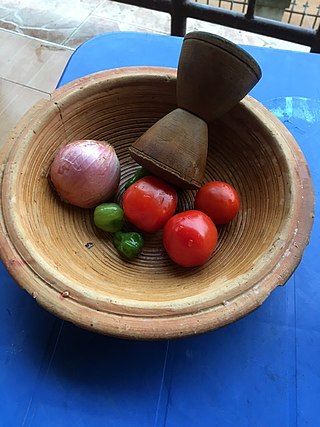
Ghana, officially the Republic of Ghana, is a country in West Africa. It abuts the Gulf of Guinea and the Atlantic Ocean to the south, sharing borders with Ivory Coast in the west, Burkina Faso in the north, and Togo in the east. Ghana covers an area of 239,567 km2 (92,497 sq mi), spanning diverse biomes that range from coastal savannas to tropical rainforests. With over 32 million inhabitants, Ghana is the second-most populous country in West Africa. The capital and largest city is Accra; other cities are Kumasi, Tamale, and Sekondi-Takoradi.

Fufu is a pounded meal found in West African cuisine. It is a Twi word that originates from the Akans in Ghana. The word has been expanded to include several variations of the pounded meal found in other African countries including Sierra Leone, Guinea, Liberia, Cote D'Ivoire, Burkina Faso, Benin, Togo, Nigeria, Cameroon, the Democratic Republic of Congo, the Central African Republic, the Republic of Congo, Angola, and Gabon.

Galamsey, derived from the phrase "gather them and sell", is local Ghanaian parlance that means illegal small-scale, gold mining in Ghana. Such workers are known as galamseyers or orpailleurs in neighboring Francophone nations. Galamseyers are people who perform illegal gold mining independent of mining companies, digging small working pits, tunnels, and sluices by hand. Galamsey is also referred to as Illegal Artisanal Small Scale mining (ASM).

Akim Oda, a town in Ghana's Eastern Region, serves as the administrative and traditional center of the Birim Central Municipal District and Akyem Kotoku, respectively. The town had 60,604 residents as of 2013.

Àmàlà is a staple swallow food popularized by the Yoruba ethnic group of Southwestern Nigeria and other parts of Yorubaland. It is made of yam, cassava flour, or unripe plantain flour. Tubers of yams are peeled, sliced, cleaned, dried and then ground into flour. It is also called èlùbọ́. Yams are white in colour but turn brown when dried which gives àmàlà its colour. It is a popular side dish served with ewédú and gbẹ̀gìrì, but is also served with a variety of other ọbè(soups), such as ẹ̀fọ́, ilá, and ogbono.

Ghanaian cuisines refer to the meals of the Ghanaian people. The main dishes of Ghana are organized around starchy staple foods, accompanied by either sauce or soup as well as a source of protein. The main ingredients for the vast majority of soups and stews are tomatoes, hot peppers, and onions. Most Ghanaian soups and stews are red or orange in appearance as a result of the main ingredients used.

Hinduism was first introduced by Sindhi settlers who migrated to Ghana after India was divided in 1947. It was spread to Ghana actively by Ghana's Hindu Monastery headed by Swami Ghananand Saraswati and by the International Society for Krishna Consciousness (ISKCON). Hinduism is one of the fastest growing religions in Ghana.

Sephardic Jewish cuisine is an assortment of cooking traditions that developed among the Sephardi Jews.

Kenkey is a staple swallow food similar to sourdough dumplings from the Ga and Fante-inhabited regions of West Africa, usually served with pepper crudaiola and fried fish, soup or stew.

Fried plantain is a dish cooked wherever plantains grow, from West Africa to East Africa as well as Central America, the tropical region of northern South America and the Caribbean countries like Haiti to Cuba and in many parts of Southeast Asia and Oceania, where fried snacks are widely popular. In Indonesia it is called gorengan. It is called ojoko in Igbo in South East Nigeria, and dodo in Yoruba in South West Nigeria, otherwise known as simply fried plantain in other parts of Nigeria. Kelewele is a fried spicy plantain or can be fried as a side dish for Red Red and fish stew in Ghana.

Waakye or Wakey is a Ghanaian dish of cooked rice and beans, commonly eaten for breakfast or lunch. However, others eat it for supper. The rice and beans, usually black eyed peas or cow beans, are cooked together, along with red dried sorghum leaf sheaths or stalks and limestone. The sorghum leaves and limestone give the dish its characteristic flavor and a red appearance and the sorghum is taken out before consumption. The word waakye is from the Hausa language and means beans. It is the contracted form of the full name shinkafa da wake which means rice and beans.

Koobi is the Akan name for salted, dried tilapia originating from Ghana. The fish has an indigenous flavor in stews and soup in the Ghanaian local delicacies. It is used to prepare Ghanaian foods such as garden egg stew, okro stew, kontomire stew and other local Ghanaian cuisines.
Zoe Adjonyoh is a British writer and cook, founder of "Zoe's Ghana Kitchen", a Ghanaian pop-up restaurant brand, which is also the title of her debut cookbook.

Gari and beans is a type of dish made of staple foods in Ghana. It is usually common in the southern parts of Ghana popularly called bober, borbor or gobɛ, yo ke gari and even red red.

Braised rice is a Ghanaian style of cooking rice. It is known as angwa moo in the Akan language, literally "oil rice" or omɔ kɛ fɔ(omor ker for) in the Ga language. It is prepared with few ingredients. and is usually balanced with some vegetables and any other accompaniment to balance the diet. The braised rice is served with ground pepper or shito, and served with fried eggs, omelette or sardine.
Brukina, also known as Burkina, it’s a Senegalese and Ivorian Drink. drink or beverage made of ground millet and pasteurized milk. Brukina is most popularly produced in the Northern regions of Ghana. It is also known as 'Deger'.

Koko is a spicy millet porridge. It is a popular Nigerian and Ghanaian street food and commonly consumed as a breakfast meal. It can also be taken in late afternoon as snack. Koko is made from many grains including millet with a few local spices added to give it a particular taste and color. It is called Hausa koko in areas where it was introduced by Hausa-speaking people. In northern Ghana, the term 'Hausa koko' is not used. Instead, porridge made from millet is called 'za koko' in Dagbanli. Several types of porridge are made from corn, millet, and sorghum. Other types of porridge include koko talli/salli, zimbuli, among others. It is also common in the various communities in both countries.

The Asanka, earthenware dish, is a Ghanaian grinding pot that is made out of clay with ridges inside. It is one of the kitchen tools commonly used in Ghanaian homes. it comes with a wooden masher called eta or tapoli in the local language. It is commonly referred to as traditional blender and appropriately used where there is no electricity. It is also called a 'pounding pot.' The Ga' s call it Kaa whiles the Akans call it apotoyewaa or Asanka. It is commonly used in the chop bars as serving bowls.
The Chop Bar is a Ghanaian food centre that serves local cuisines in a contemporary dining setting. It was founded by Elias Hage and Mona Quartey El Halabi in 2015

Agbeli Kaklo is a Ghanaian and Togolese snack made from cassava and eaten by the locals, the snack originated from the southern part of the Volta Region. It is very crunchy and mostly eaten with hard coconut. The snack is named as such because it is derived from cassava.



















